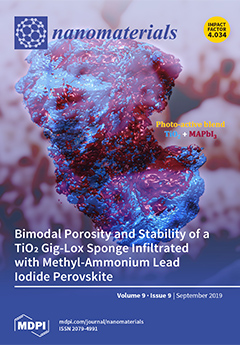Antimony sulfide (Sb
2S
3) with a high theoretical capacity is considered as a promising candidate for Na-ion batteries (NIBs) and K-ion batteries (KIBs). However, its poor electrochemical activity and structural stability are the main issues to be solved. Herein, amorphous
[...] Read more.
Antimony sulfide (Sb
2S
3) with a high theoretical capacity is considered as a promising candidate for Na-ion batteries (NIBs) and K-ion batteries (KIBs). However, its poor electrochemical activity and structural stability are the main issues to be solved. Herein, amorphous Sb
2S
3 nanospheres/carbon nanotube (Sb
2S
3/CNT) nanocomposites are successfully synthesized via one step self-assembly method. In-situ growth of amorphous Sb
2S
3 nanospheres on the CNTs is confirmed by X-ray diffraction, field-emission scanning electron microscopy, and transmission electron microscopy. The amorphous Sb
2S
3/CNT nanocomposites as an anode for NIBs exhibit excellent electrochemical performance, delivering a high charge capacity of 870 mA h g
−1 at 100 mA g
−1, with an initial coulomb efficiency of 77.8%. Even at 3000 mA g
−1, a charge capacity of 474 mA h g
−1 can be achieved. As an anode for KIBs, the amorphous Sb
2S
3/CNT nanocomposites also demonstrate a high charge capacity of 451 mA h g
−1 at 25 mA g
−1. The remarkable performance of the amorphous Sb
2S
3/CNT nanocomposites is attributed to the synergic effects of the amorphous Sb
2S
3 nanospheres and 3D porous conductive network constructed by the CNTs.
Full article






